Look, Learn & Create Origami


 Copyright 2011
Copyright 2011
Creative Publishing international, Inc.
400 First Avenue North Suite 300
Minneapolis, Minnesota 55401
1-800-328-3895
www.creativepub.com
www.qbookshop.com All rights reserved. Printed in China 10 9 8 7 6 5 4 3 2 1 Digital edition: 978-1-6106-0194-8
Softcover edition: 978-1-5892-3606-6 Library of Congress Cataloging-in-Publication
Coleman, Benjamin John.
Origami 101 / Benjamin Coleman.
p. cm.
Summary: Beginners guide to origami, with instructions, photos, and diagrams for folding fifty paper figures.-- Provided by publisher.
ISBN-13: 978-1-58923-606-6 (hard cover with DVD)
ISBN-10: 1-58923-606-8 (hard cover with DVD)
1. Origami. I. Title.
TT870.C6163 2011
736.982--dc22
2010046926 Photography, Illustrations, and Videography:
Benjamin John Coleman
Cover & Book Design: Mighty Media
Page Layout: Danielle Smith Visit www.Craftside.Typepad.com for a behind-the-scenes peek at our crafty world! Due to differing conditions, materials, and skill levels, the publisher and various manufacturers disclaim any liability for unsatisfactory results or injury due to improper use of tools, materials, or information in this publication. All rights reserved. No part of this work covered by the copyrights hereon may be reproduced or used in any form or by any meansgraphic, electronic, or mechanical, including photocopying, recording, taping of information on storage and retrieval systemswithout the written permission of the publisher. The publisher grants to the reader permission to reproduce the origami papers in the back of the book for personal use. CONTENTSIntroductionOrigami literally means fold paper in Japanese. Ori means fold and gami, or kami in Japanese, means paper.
The art form was started in China and then brought to Japan where it became quite popular by 1614. Traditional origami is performed on a square that is colored on one side. There is no tearing or cutting allowed. Origami folding patterns have been used in the design of spacecraft parts since the 1980s when Koryo Miuras origami-based solar panels flew on a Japanese rocket. A mass-produced origami folding pattern is as close to you as the air bag in your car. The first mass-produced origami flower was introduced in 2010 by the author of this book. Origami is increasingly used in engineering consumer products.
Cellular phones with self-folding antennae for better reception and microchips that automatically reconfigure themselves through folding are likely under development. One newer origami technique is called crumple folding, where the paper is crumpled rather than folded. This has led to highly complex paper models that cannot be repeated exactly. Origami has moved beyond traditional squares. The flowers on this page were made with a star shape, which is then folded using an origami pattern, but a glass cutter is used to impress the folds on the paper first.  How to Use This Book This book was designed by an origami enthusiast to teach those unfamiliar with origami how to fold.
How to Use This Book This book was designed by an origami enthusiast to teach those unfamiliar with origami how to fold.
Directions for folding origami figures always include symbols, and the key to success is learning what these symbols mean and how to execute them. Rather than create a long introductory chapter consisting of folding symbols and their descriptions, folding symbols are explained as they are encountered. Each folding symbol is explained in a blue box near the step where it is introduced in a pattern. This gives you immediate explanation of a new symbol. Detailed photographs help you along the way. You will find a Symbol Index Bookmark at the back of the book, which shows the folding symbols and the page numbers where they are explained.
You can cut out one bookmark to mark pages while you fold and keep the other one in the book for quick reference. Whenever you dont remember what a symbol means, just flip to the Symbol Index and turn to the page indicated.  Top: blue boxes explain symbols. Bottom left: diagrams. Bottom right: detail photos. New Symbol: Glow and Afterglow
Top: blue boxes explain symbols. Bottom left: diagrams. Bottom right: detail photos. New Symbol: Glow and Afterglow Learning a three-dimensional art form like origami from a two-dimensional page isnt easy.
Learning a three-dimensional art form like origami from a two-dimensional page isnt easy.
One of the advances you will find in the diagrams in this book is called glowfold. Glowfold tells you what surface is going to move during a fold and where it went after it was folded. A surface that is about to be folded will glow with a red hue on top of it. In the diagram that follows, you will see afterglow. This afterglow not only tells you what surface moved, but it also tells you where the open edges should be and how to confirm the orientation of your paper. The afterglow will only be present in the step immediately following a step where glow was present.
Here is an example of how it works:  1. A square is being folded in half horizontally. The surface that will move glows.
1. A square is being folded in half horizontally. The surface that will move glows.  2. After folding, glow escapes from the open edges. New Symbol: Fold
2. After folding, glow escapes from the open edges. New Symbol: Fold The fold symbol consists of a purple arc with an arrowhead on one end and a circle on the other. New Symbol: Fold
The fold symbol consists of a purple arc with an arrowhead on one end and a circle on the other. New Symbol: Fold The fold symbol consists of a purple arc with an arrowhead on one end and a circle on the other.
The fold symbol consists of a purple arc with an arrowhead on one end and a circle on the other.
A green dashed (or occasionally a red dotted and dashed) line will appear underneath and perpendicular to it. This is probably the most common, powerful, and easy-to-master symbol in origami. It is important that you learn the proper way to make a fold. The quality of your finished origami model is directly related to your ability to align the paper and then impress the fold into it. Every fold you make should conform to the following steps:  1. Figure out what the diagram is telling you.
1. Figure out what the diagram is telling you.
This diagram tells us to fold the paper in half horizontally, bottom to top.  2. Reorient your square so making the fold is as comfortable and easy as possible. In this case, to precisely align the edges, I rotate the square 90 degrees before folding it.
2. Reorient your square so making the fold is as comfortable and easy as possible. In this case, to precisely align the edges, I rotate the square 90 degrees before folding it. 
Next page



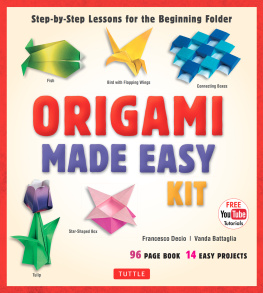
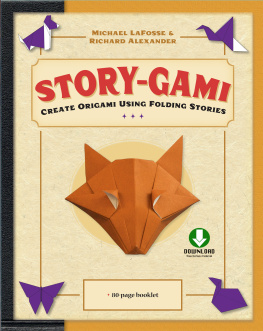

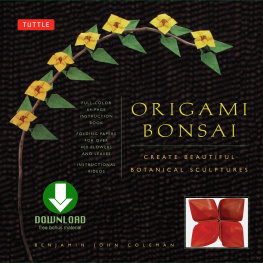

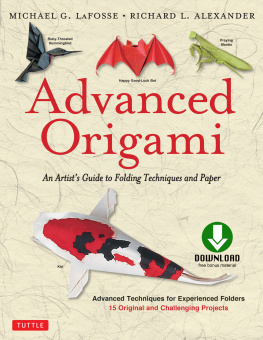
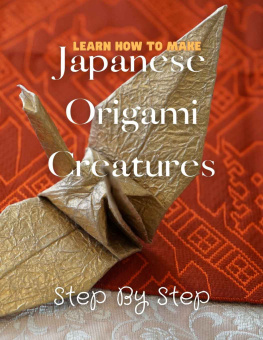

![Marcia Joy Miller - Origami for Busy People: 27 Original On-The-Go Projects [Origami Book, 48 Papers, 27 Projects]](/uploads/posts/book/151502/thumbs/marcia-joy-miller-origami-for-busy-people-27.jpg)



 How to Use This Book This book was designed by an origami enthusiast to teach those unfamiliar with origami how to fold.
How to Use This Book This book was designed by an origami enthusiast to teach those unfamiliar with origami how to fold. Top: blue boxes explain symbols. Bottom left: diagrams. Bottom right: detail photos. New Symbol: Glow and Afterglow
Top: blue boxes explain symbols. Bottom left: diagrams. Bottom right: detail photos. New Symbol: Glow and Afterglow Learning a three-dimensional art form like origami from a two-dimensional page isnt easy.
Learning a three-dimensional art form like origami from a two-dimensional page isnt easy. 1. A square is being folded in half horizontally. The surface that will move glows.
1. A square is being folded in half horizontally. The surface that will move glows.  2. After folding, glow escapes from the open edges. New Symbol: Fold
2. After folding, glow escapes from the open edges. New Symbol: Fold The fold symbol consists of a purple arc with an arrowhead on one end and a circle on the other. New Symbol: Fold
The fold symbol consists of a purple arc with an arrowhead on one end and a circle on the other. New Symbol: Fold 1. Figure out what the diagram is telling you.
1. Figure out what the diagram is telling you. 2. Reorient your square so making the fold is as comfortable and easy as possible. In this case, to precisely align the edges, I rotate the square 90 degrees before folding it.
2. Reorient your square so making the fold is as comfortable and easy as possible. In this case, to precisely align the edges, I rotate the square 90 degrees before folding it. 